
Wine Culture and Information since 2002 - Volume 22
 Wine Culture and Information since 2002 - Volume 22 |
|
Issue 202, January 2021 |
Contents |
|
|
The Price Paid by Wine |
|
We knew it. For many months we had been aware of what was going to happen in the wine market. A prediction, not so difficult to make, and which obviously happened. We have known for months that because of the pandemic and the impact it has had on the economy, any productive area would have been significantly affected and, in some cases, even in a devastating way. We also knew the economic consequences and the restrictive measures affecting trading activities and related to the world of wine would have had a very heavy impact on the market and on all producers. Those who could and were in the economic condition to do so, obviously tried to resist by resorting to the resources available and which, of course, were not and are not unlimited. Those who have not been able to do that, or have run out of resources, tried to remedy as much as possible, understandably trying not to succumb. In the past months, and this is nothing new, the global wine market has suffered a significant and certainly unpredictable collapse, both because of the Covid-19 pandemic and certain economic and protectionist measures adopted by some countries. Many, in my opinion and even rashly, hailed the foreseeable increase in so-called on-line sales as the lifeline for the wine market. There are even some who have speculated this will be the preferential way for the future of the wine market and it will save it from the crisis of these times. There is no doubt that selling through e-commerce platforms has in part limited the damage caused by the loss in sales of conventional channels. It in fact “limited” it, probably in a negligible way for many. On-line wine sales have clearly increased, mainly because of the fact, in many cases, it has been and is the only way to sell wine. Many people emphasize the extraordinary increases in e-commerce sales of wine which, in some cases, has been even higher than 400%. A value that certainly seems to be striking, however it has no concrete meaning without the comparison with the generated volume, in particular with the turnover prior to the current situation. If a winery, in fact, before the pandemic, recorded, for example, a turnover in e-commerce sales of a few hundred euros per month, an increase of 400% does not significantly affect the balance of a medium-sized company. This is because, above all, the sale through electronic commerce is mainly about the retail channel, made up of purchases of some bottles, certainly not the volumes typical of large-scale distribution. If we add to this the obvious decrease in people's spending power, the situation becomes even more serious. The restaurants and business activities that have always been the main sales channel for wine, are also in a very serious situation, forced to not be able to do their jobs, have drastically affected the collapse in sales. The consequence is that wineries are in the position of having a quantity of unsold bottles and casks which are still full and that, in some way and like to say, must be emptied. Not only for the fact of seeking the legitimate profit, but also to free up space to make room for the wine of the 2020 harvest and the bottles that will be produced. We know that some recovery measures have been implemented, authorizing, for example, the extraordinary distillation of large quantities of wine. In this regard, it should be considered that a distillery is interested in the alcoholic fraction of the wine only, they do not give much consideration to the denomination or the label, not even the prestige or the work done to make a wine. Alcohol – that is, the product the distilleries are interested into – is always the same, from table wines to those belonging to Denominazione d'Origine Controllata e Garantita (Denomination of Controlled and Guaranteed Origin, DOCG): the price is the same in any case. Wine in restaurants has suffered a huge decline in sales, in supermarkets – notoriously – are preferentially sold wines belonging to a certain price range, so to speak “popular”, in wine shops are also sold “prestigious” labels, the electronic commerce channel sells a bit of everything. However, the fact remains that wineries and consortia have the problem of how to sell what was not possible to sell. Even at the cost of selling off their products, as it would always be more than the price paid by the distilleries. It is no coincidence that I said “products” – evidently alluding to wine – obviously excluding the “brand” which, for many producers, represents the main reason for their profits. Many wine producers – big and small, including consortia – have always sold their wines with specially designed brands, thus avoiding the involvement of the primary brand, with the aim of selling wines at a much lower price, therefore obtaining an immediate profit. This sales method covers all categories of wine, from table to DOCG, that is, those having a Denomination of Controlled and Guaranteed Origin. I think everyone has seen DOC or DOCG wines at surprisingly low and unusual prices on the shelves in a supermarket. There is no need to underline the quality of what is inside the bottle: we all agree that real and true quality has a decidedly high cost. When a wine has obtained the recognition of the denomination, that is, it satisfies the production criteria provided for by its disciplinary, it has the full right to bear the name of denomination in the label. The production disciplinary, it must be said, establishes only the production and geographic criteria, it makes no reference to the selling price, not even to the minimum one. This means the producer has the right to set the price of the wine, even at prices much lower than the competition and the average price at which the denomination is usually sold. It could be said that this is detrimental to the prestige of the denomination and obviously disturbs its target market, however – to paraphrase a famous movie cue – “that's the free market, baby”. As far as I'm concerned, I understand these sell-off choices by producers and consortia. I do not feel like criticizing that, I understand the difficulties of the moment, both economic, logistic and, above all, entrepreneurial. It does not cause me any discomfort, personally, to see wines from “noble and celebrated” wine areas on the supermarket shelves at obviously unlikely and highly questionable prices. Nobody forces me to buy them and, in fact, I don't buy them. I know well, just like anyone else, there are fixed costs to bottle a wine that have a quite important impact. By doing a quick calculation, it is evident the proposed price for those bottles can barely cover the cost of bottling, let alone that of wine. Therefore, anyone is absolutely aware that in those bottles they will not find a “sublime nectar”, despite the name and denomination written in the label. If I buy that type of wine, I certainly don't expect to be surprised by the high quality, rather, by the low if not poor one, and this is something everyone knows even before putting that bottle in the cart. Moreover, we all know very well this year has been very difficult for everyone, for every business sector, with very high losses in profits. Wineries – which evidently are, first of all, business activities – have notoriously suffered the enormous economic consequences imposed by both the pandemic and the market conditions of 2020. With the result of having huge quantities of unsold bottles. And every bottle not sold takes up space and that will not be freed for the bottles of the new vintage. For this reason, and as far as I'm concerned, I fully understand the entrepreneurial need to accept the “loss” caused by the sale and which, certainly, would be even more significant in case this would also affect future productions. Then it is better to sell them out, to close the “2020 chapter” with the awareness of the loss and starts again for the future. If then on the shelves we see “noble” wines at unjustified, unlikely and evidently popular prices, the final choice is up to the consumer. They can in fact choose whether to accept to buy a bottle with consciously questionable and predictable quality, paid at a very low price, or to leave it on the shelf. With all due respect to those who cry at the alleged treason scandal. Antonello Biancalana
|
||||
Contrasts of Cerasuolo di Vittoria and Valtellina SuperioreSicily and Lombardy are being compared in the glasses of this month's tasting with two clearly distant wines, both ranked as Denomination of Controlled and Guaranteed Origin |
|
Sicily and Lombardy are extremely distant wine-growing territories and not only for geographical reasons. Different grapes and of course different viticultural methods, not least, different climate and weather conditions. Even the ampelographic scenario of the two regions – with the exception of the so-called international varieties, which are widespread throughout Italy – is characterized by the presence of indigenous varieties which are decidedly different from a sensorial and enological point of view. This month we will pour in our glasses two significant and representative wines of Sicily and Lombardy, both belonging to the highest ranking of the Italian quality system: Denominazione d'Origine Controllata e Garantita (Denomination of Controlled and Guaranteed Origin, DOCG). The comparison by contrast of this month is very interesting, both for the effect of the soil and climate in the two wines, and – and above all – for the substantial differences of the grapes with which they are produced. The wines we will pour into our glasses are Cerasuolo di Vittoria – the only wine in Sicily ranked as DOCG – and Valtellina Superiore, the undisputed glory of the enology of Lombardy and of the province of Sondrio. The Sicilian wine is mainly produced with Nero d'Avola in addition to Frappato, while the Lombard wine – according to its production disciplinary – is mainly produced with Nebbiolo grape and the possible remaining small part can be represented by varieties allowed for cultivation in Lombardy. They are obviously three extremely different varieties, in particular for the gustatory profile of their wines. Nebbiolo is among the grapes having the highest content in polyphenolic substances – also known as “tannins” – and its wines are also characterized by an appreciable acidity. The wines produced with Nero d'Avola have an evidently different profile, with a decidedly more modest content of polyphenolic substances and an evidently rounder character. However, acidity is found in Frappato, a quality contributing to the good balance of Cerasuolo di Vittoria.
|
|
Cerasuolo di Vittoria is the only wine in Sicily to belong to the classification of the Denominazione d'Origine Controllata e Garantita (Denomination of Controlled and Guaranteed Origin, DOCG). This interesting wine is produced with two indigenous varieties of the region: Nero d'Avola and Frappato. The first variety is among the most common and well-known ones in Sicily and is widely used in the wines of the entire region as well as in many Denomination of Controlled Origin (DOC) wines of the island, both alone and blended to other varieties. Frappato is decidedly less widespread than Nero d'Avola and is particularly common in the territory of Vittoria, a town in the province of Ragusa. According to the production disciplinary, Cerasuolo di Vittoria is produced with a minimum of 50% and a maximum of 70% of Nero d'Avola with the remaining part of Frappato. It should be noted that, although the wine takes the name of the town of Vittoria – in the province of Ragusa – its production is also allowed in some areas of the provinces of Caltanissetta and Catania. The two varieties making up this wine – Nero d'Avola and Frappato – have their own qualities and personalities, such as to balance, so to speak, the other with opposite sensorial characteristics. Nero d'Avola, in fact, makes wines with good roundness and alcohol by volume, as well as moderate astringency, while Frappato makes, among the other things, wines with an appreciable and pleasing crispness given by acidity, something allowing Cerasuolo di Vittoria to get an excellent balance. In this regard, it should be noted the individual qualities of Nero d'Avola and Frappato are perfectly recognizable and distinguishable in Cerasuolo di Vittoria, even when the wine is aged in cask or barrique. Even the olfactory personality of the two varieties have full expression in this wine, in particular the sensations of dark pulp fruits of Nero d'Avola and those reminiscent of flowers and red pulp fruits typical of Frappato, which – in some cases – can also express a pleasing spicy note of black pepper.
|
||||
|
In the suggestive mountain scenario of the Alps, in the province of Sondrio, is produced one of the most interesting wines of Lombardy: Valtellina Superiore. This wine, classified as Denominazione d'Origine Controllata e Garantita (Denomination of Controlled and Guaranteed Origin, DOCG), Nebbiolo variety is the indisputable protagonist of this wine, in the Valtellina area also known as Chiavennasca. According to its production disciplinary, Valtellina Superiore is produced with at least 90% Nebbiolo and the remaining part with non-aromatic red grapes allowed for cultivation in Lombardy. In this regard, it must be said that almost all producers of this wine prefer to make it with 100% Nebbiolo, a choice that obviously gives this wine a greater personality. Valtellina Superiore is strongly influenced by the environment and the mountain climate of the Alps, qualities giving this wine a marked elegance in which the typical acidity of Nebbiolo plays an important role, while expressing its characteristic and impressive structure. Valtellina Superiore, according to its production disciplinary, provides for the definition of five sub-areas and, specifically, Sassella, Inferno, Grumello, Valgella and Maroggia. To these mentions is also added Valtellina Superiore Sforzato – or Sforzato della Valtellina – which is produced by using dried grapes. It should also be noted this wine also provides for the mention “Stägafässli” in case it is bottled in the Swiss Confederation. In this specific case – unlike the other mentions – the “riserva” style cannot be produced and in the label cannot be mentioned any sub-area. The production of Valtellina Superiore requires a minimum period of aging, before being marketed, for at least 24 months, 12 of which in cask. This period extends to 36 months for the “riserva” style. Viticulture in Valtellina, because of the specific conditions of the territory, is not always easy and the vineyards are often found in steep areas, a condition making cultivation and harvesting operations not exactly simple. For this reason, the viticulture of Valtellina is often defined as “heroic”.
|
Before starting this month's tasting by contrast, let's choose the two wines we will pour into the glasses. It must be said that, in both cases, the choice is not particularly difficult as they are well represented and available on the market. As for Cerasuolo di Vittoria, we will choose a bottle mainly produced with Nero d'Avola, ideally 60% and, therefore, the remaining 40% of Frappato. As for the aging, we will pay attention in choosing a wine aged in cask for a few months, in order to have an enological condition similar to the one of Valtellina Superiore. As for the Lombard wine, we will make sure it is produced with 100% Nebbiolo grape. A condition which can be defined as “normal” – although the disciplinary provides for the use of a small part of other grapes – as almost all the wine of this appellation is exclusively produced with Nebbiolo. Furthermore, we will choose a Valtellina Superiore with no other mention, therefore not belonging to any sub-aera or “riserva”, aged in cask. The two wines are poured into their respective tasting glasses at a temperature of 18 °C (65 °F). Let's pour Cerasuolo di Vittoria and Valtellina Superiore into their respective glasses and start this month's tasting by contrast. As usual, by following the logical sequence of sensorial analysis, we begin with the evaluation of the appearance of the wines, by examining Cerasuolo di Vittoria. Let's tilt its glass over a white surface and observe the base, in order to evaluate color and transparency. The Sicilian wine shows an intense and brilliant ruby red color, moreover, by placing an object between the glass and the white surface, we can see a moderate transparency. Let's now observe Cerasuolo di Vittoria towards the opening of the glass: the nuance confirms the ruby red hue. Let's now pass to the evaluation of the aspect of Valtellina Superiore and, as for the previous wine, let's tilt the glass over the white surface. The color of the Lombard wine shows a brilliant ruby red, lighter than Cerasuolo di Vittoria. Transparency is, also in this case, moderate, however higher than that of the Sicilian wine. The nuance of Valtellina Superiore – observed at the edge of the glass – reveals a ruby red hue tending to garnet. The olfactory profiles of Cerasuolo di Vittoria and Valtellina Superiore are distinguished by rather distant sensorial differences. The Sicilian wine, thanks to the contribution of Nero d'Avola and Frappato, reveals to the nose rather variegated aromas expressing sensations reminiscent of black and red pulp fruits, as well as aromas directly recalling floral fragrances. In fact, in this wine Nero d'Avola contributes mainly with aromas of dark pulp fruits, while Frappato with red pulp ones as well as aromas reminiscent of flowers. Furthermore, this latter grape can – in certain cases and depending on viticultural and enological practices – give Cerasuolo di Vittoria a pleasing spicy aroma in which can be recognized black pepper. The olfactory profile of Valtellina Superiore is characterized, of course, by the qualities of Nebbiolo, therefore in this wine are mainly perceived aromas of red pulp fruits and flowers. Let's continue our tasting by contrast and evaluate the olfactory profiles of Cerasuolo di Vittoria and Valtellina Superiore. The first wine of which we will examine its aromas is, as in the previous evaluation, Cerasuolo di Vittoria. Let's hold the glass of the Sicilian wine in vertical position and, without swirling, let's do the first smell in order to appreciate the opening, that is the initial and identifying sensations of the wine. From the glass we can appreciate intense and clean aromas of black cherry, blackberry and raspberry, as well as a pleasing aroma reminiscent of violet. After having swirled the glass, the olfactory profile of Cerasuolo di Vittoria is completed with strawberry, plum, blueberry, cyclamen, rose and, sometimes, the black pepper given by Frappato. Let's now pass to the olfactory evaluation of Valtellina Superiore and let's do the first smell: the Lombard wine is identified with cherry, plum and violet, a rather typical opening for wines produced with Nebbiolo grape. Let's swirl the glass of Valtellina Superiore and do the second smell: the Lombard wine is completed with strawberry, rose and raspberry. In both wines, of course, we can clearly perceive the olfactory sensations typical of the aging in wood, in particular vanilla. Let's now pass to the gustatory evaluation of the two wines, starting with Cerasuolo di Vittoria. Let's take a sip of the Sicilian wine and evaluate its attack, that is, the initial sensations perceived in the mouth. Cerasuolo di Vittoria is characterized by the pleasing roundness of Nero d'Avola and the aging in wood which is contrasted by the crispness given by Frappato. Roundness is further accentuated by the effect of alcohol, in a gustatory profile in which astringency – although perceptible – does not tend to dominate, despite having a good structure. In the mouth we can perceive the flavors of black cherry, blackberry and raspberry, confirming the good correspondence to the nose. Let's now take a sip of Valtellina Superiore and evaluate its attack. In the mouth, compared to the Sicilian wine, it is perceived a greater sensation of structure, decidedly full, in which the astringent effect of the tannins of Nebbiolo as well as of its typical and evident crispness given by acidity are immediately perceived. We also distinctly perceive in the mouth the flavors of cherry, plum and raspberry, confirming – also in this case – the good correspondence to the nose. We are at the end of this month's tasting by contrast, therefore let's evaluate the final sensations Cerasuolo di Vittoria and Valtellina Superiore leave in the mouth, in particular, the taste-olfactory persistence. The finish of Cerasuolo di Vittoria is persistent and in the mouth leaves a pleasing sensation of roundness and crispness, in which the effects of alcohol and the moderate astringency are still perceived. We can also perfectly distinguish in the mouth flavors of black cherry, blackberry and raspberry, with a decidedly pleasing sensation. The finish of Valtellina Superiore is characterized by a good persistence, leaving in the mouth a sensation of remarkable structure – much greater than Cerasuolo di Vittoria – as well as the effects of the astringency of tannins and the crispness of acidity, both more intense than in the Sicilian wine. In the mouth we can also perceive, clear and intense, the flavors of cherry, plum, raspberry and strawberry. Two wines which are evidently distant, in every respect, both from a geographical and a sensorial point of view, however both elegant and with evident personality.
|
||||||||
Wines of the Month |
|
|
|
Score legend Prices are to be considered as indicative. Prices may vary according to the country or the shop where wines are bought |
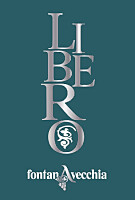
|
|
Falanghina del Sannio Taburno Libero 2014 |
|
| Fontanavecchia (Campania, Italy) | |
 Falanghina Falanghina | |
| Price: € 21.00 | Score: |
 Brilliant golden yellow and nuances of golden yellow, very transparent. Brilliant golden yellow and nuances of golden yellow, very transparent. Intense, clean, pleasing, refined and elegant, starts with hints of
apple, plum and hazelnut followed by aromas of citrus fruits, hawthorn,
medlar, quince jam, pear jam, honey, linden, praline, mineral and hints of
vanilla. Intense, clean, pleasing, refined and elegant, starts with hints of
apple, plum and hazelnut followed by aromas of citrus fruits, hawthorn,
medlar, quince jam, pear jam, honey, linden, praline, mineral and hints of
vanilla.
 Crisp attack and however balanced by alcohol, good body, intense
flavors, pleasing roundness. Crisp attack and however balanced by alcohol, good body, intense
flavors, pleasing roundness.
 Persistent finish with flavors of apple, plum and hazelnut. Persistent finish with flavors of apple, plum and hazelnut. Aged in steel tanks. A small part ages for 6 months in barrique. 12
months in bottle. Aged in steel tanks. A small part ages for 6 months in barrique. 12
months in bottle.
|
|
 Stuffed pasta with mushrooms, Roasted fish, Stewed white meat, Broiled fish, Mushroom soups Stuffed pasta with mushrooms, Roasted fish, Stewed white meat, Broiled fish, Mushroom soups |
|
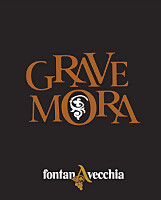
|
|
Aglianico del Taburno Riserva Grave Mora 2012 |
|
| Fontanavecchia (Campania, Italy) | |
 Aglianico Aglianico | |
| Price: € 33.00 | Score: |
 Deep ruby red and nuances of garnet red, little transparency. Deep ruby red and nuances of garnet red, little transparency. Intense, clean, pleasing, refined and elegant, starts with hints of
plum, blackberry and dried violet followed by aromas of black cherry,
blueberry, cocoa, tobacco, cinchona, leather, licorice, mace, graphite,
menthol and vanilla. Intense, clean, pleasing, refined and elegant, starts with hints of
plum, blackberry and dried violet followed by aromas of black cherry,
blueberry, cocoa, tobacco, cinchona, leather, licorice, mace, graphite,
menthol and vanilla.
 Properly tannic attack and however balanced by alcohol, full body,
intense flavors, pleasing crispness. Properly tannic attack and however balanced by alcohol, full body,
intense flavors, pleasing crispness.
 Persistent finish with flavors of plum, blackberry and black cherry. Persistent finish with flavors of plum, blackberry and black cherry. 18 months in barrique, 12 months in bottle. 18 months in barrique, 12 months in bottle. |
|
 Game, Roasted meat, Stewed and braised meat, Hard cheese Game, Roasted meat, Stewed and braised meat, Hard cheese |
|
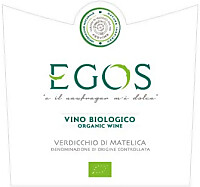
|
|
Verdicchio di Matelica Egos 2019 |
|
| Provima - Produttori Vitivinicoli Matelica (Marches, Italy) | |
 Verdicchio Verdicchio | |
| Price: € 8.00 | Score: |
 Brilliant straw yellow and nuances of greenish yellow, very
transparent. Brilliant straw yellow and nuances of greenish yellow, very
transparent.
 Intense, clean, pleasing and refined, starts with hints of apple, peach
and pear followed by aromas of broom, hawthorn, plum, chamomile, citrus
fruits, almond and mineral. Intense, clean, pleasing and refined, starts with hints of apple, peach
and pear followed by aromas of broom, hawthorn, plum, chamomile, citrus
fruits, almond and mineral.
 Crisp attack and however balanced by alcohol, good body, intense
flavors, agreeable. Crisp attack and however balanced by alcohol, good body, intense
flavors, agreeable.
 Persistent finish with flavors of apple, peach and pear. Persistent finish with flavors of apple, peach and pear. Aged in steel tanks. Aged in steel tanks. |
|
 Fish appetizers, Risotto with fish, Fried fish, Sauteed fish, Dairy products Fish appetizers, Risotto with fish, Fried fish, Sauteed fish, Dairy products |
|
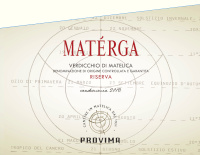
|
|
Verdicchio di Matelica Riserva Materga 2017 |
|
| Provima - Produttori Vitivinicoli Matelica (Marches, Italy) | |
 Verdicchio Verdicchio | |
| Price: € 14.00 | Score: |
 Intense straw yellow and nuances of golden yellow, very transparent. Intense straw yellow and nuances of golden yellow, very transparent. Intense, clean, pleasing, refined and elegant, starts with hints of
apple, plum and hawthorn followed by aromas of pear, grapefruit, peach,
broom, chamomile, pineapple, mineral and almond. Intense, clean, pleasing, refined and elegant, starts with hints of
apple, plum and hawthorn followed by aromas of pear, grapefruit, peach,
broom, chamomile, pineapple, mineral and almond.
 Crisp attack and however balanced by alcohol, good body, intense
flavors, agreeable. Crisp attack and however balanced by alcohol, good body, intense
flavors, agreeable.
 Persistent finish with flavors of apple, plum and grapefruit. Persistent finish with flavors of apple, plum and grapefruit. 12 months in steel tanks, at least 6 months in bottle. 12 months in steel tanks, at least 6 months in bottle. |
|
 Stuffed pasta, Roasted white meat, Roasted fish, Stewed fish with mushrooms Stuffed pasta, Roasted white meat, Roasted fish, Stewed fish with mushrooms |
|
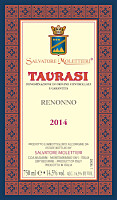
|
|
Taurasi Renonno 2014 |
|
| Salvatore Molettieri (Campania, Italy) | |
 Aglianico Aglianico | |
| Price: € 30.00 | Score: |
 Intense ruby red and nuances of garnet red, little transparency. Intense ruby red and nuances of garnet red, little transparency. Intense, clean, pleasing, refined and elegant, starts with hints of
plum, blackberry and black cherry followed by aromas of dried violet,
tobacco, cocoa, cinnamon, leather, licorice, rhubarb, graphite, vanilla and
menthol. Intense, clean, pleasing, refined and elegant, starts with hints of
plum, blackberry and black cherry followed by aromas of dried violet,
tobacco, cocoa, cinnamon, leather, licorice, rhubarb, graphite, vanilla and
menthol.
 Properly tannic attack and however balanced by alcohol, full body,
intense flavors, pleasing crispness. Properly tannic attack and however balanced by alcohol, full body,
intense flavors, pleasing crispness.
 Persistent finish with flavors of plum, blackberry and black cherry. Persistent finish with flavors of plum, blackberry and black cherry. 36 months in cask and barrique, at least 6 months in bottle. 36 months in cask and barrique, at least 6 months in bottle. |
|
 Game, Roasted meat, Stewed and braised meat, Hard cheese Game, Roasted meat, Stewed and braised meat, Hard cheese |
|
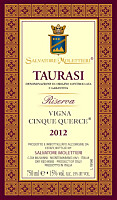
|
|
Taurasi Riserva Vigna Cinque Querce 2012 |
|
| Salvatore Molettieri (Campania, Italy) | |
 Aglianico Aglianico | |
| Price: € 49.00 | Score: |
 Deep ruby red and nuances of garnet red, little transparency. Deep ruby red and nuances of garnet red, little transparency. Intense, clean, pleasing, refined and elegant, starts with hints of
blackberry, plum and dried violet followed by aromas of black cherry,
blueberry, cocoa, tobacco, carob, cinnamon, licorice, leather, mace,
rhubarb, graphite, menthol and vanilla. Intense, clean, pleasing, refined and elegant, starts with hints of
blackberry, plum and dried violet followed by aromas of black cherry,
blueberry, cocoa, tobacco, carob, cinnamon, licorice, leather, mace,
rhubarb, graphite, menthol and vanilla.
 Properly tannic attack and however balanced by alcohol, full body,
intense flavors, pleasing crispness. Properly tannic attack and however balanced by alcohol, full body,
intense flavors, pleasing crispness.
 Very persistent finish with long flavors of blackberry, plum and black
cherry. Very persistent finish with long flavors of blackberry, plum and black
cherry.
 60 months in barrique, at least 6 months in bottle. 60 months in barrique, at least 6 months in bottle. |
|
 Game, Roasted meat, Stewed and braised meat, Hard cheese Game, Roasted meat, Stewed and braised meat, Hard cheese |
|
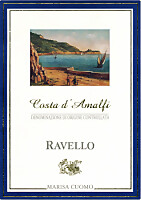
|
|
Costa d'Amalfi Ravello Bianco 2019 |
|
| Marisa Cuomo (Campania, Italy) | |
 Falanghina (60%), Biancolella (40%) Falanghina (60%), Biancolella (40%) | |
| Price: € 15.00 | Score: |
 Intense straw yellow and nuances of straw yellow, very transparent. Intense straw yellow and nuances of straw yellow, very transparent. Intense, clean, pleasing and refined, starts with hints of apple, peach
and plum followed by aromas of pear, hawthorn, jasmine, lily, broom, citrus
fruits, hazelnut and mineral. Intense, clean, pleasing and refined, starts with hints of apple, peach
and plum followed by aromas of pear, hawthorn, jasmine, lily, broom, citrus
fruits, hazelnut and mineral.
 Crisp attack and however balanced by alcohol, good body, intense
flavors, agreeable. Crisp attack and however balanced by alcohol, good body, intense
flavors, agreeable.
 Persistent finish with flavors of apple, peach and plum. Persistent finish with flavors of apple, peach and plum. 4 months in steel tanks. 4 months in steel tanks. |
|
 Pasta with fish, Fried fish, Sauteed white meat, Sauteed fish, Dairy products Pasta with fish, Fried fish, Sauteed white meat, Sauteed fish, Dairy products |
|
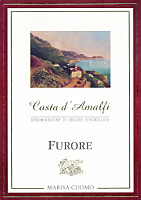
|
|
Costa d'Amalfi Furore Rosso 2019 |
|
| Marisa Cuomo (Campania, Italy) | |
 Piedirosso (50%), Aglianico (50%) Piedirosso (50%), Aglianico (50%) | |
| Price: € 16.00 | Score: |
 Intense ruby red and nuances of purple red, little transparency. Intense ruby red and nuances of purple red, little transparency. Intense, clean, pleasing and refined, starts with hints of black
cherry, plum and blueberry followed by aromas of violet, pomegranate,
blackberry, rose, carob, black pepper and hints of vanilla. Intense, clean, pleasing and refined, starts with hints of black
cherry, plum and blueberry followed by aromas of violet, pomegranate,
blackberry, rose, carob, black pepper and hints of vanilla.
 Properly tannic attack and however balanced by alcohol, good body,
intense flavors, pleasing crispness. Properly tannic attack and however balanced by alcohol, good body,
intense flavors, pleasing crispness.
 Persistent finish with flavors of black cherry, plum and pomegranate. Persistent finish with flavors of black cherry, plum and pomegranate. 6 months in barrique. 6 months in barrique. |
|
 Pasta with meat and mushrooms, Stewed meat with mushrooms, Cheese Pasta with meat and mushrooms, Stewed meat with mushrooms, Cheese |
|
News |
|
In this section are published news and information about events concerning the world of wine and food. Whoever is interested in publishing this kind of information can send us a mail to our address.
|
AquavitaeReview of Grappa, Distillates and Brandy |
|
|
||||||||||||
Wine Guide ParadeOctober 2020
|
| |||||||
Privacy Policy | |||||||


| Copyright © 2002-2024 Antonello Biancalana, DiWineTaste - All rights reserved |
| All rights reserved under international copyright conventions. No part of this publication and of this WEB site may be
reproduced or utilized in any form or by any means, electronic or mechanical, without permission in writing from DiWineTaste. |